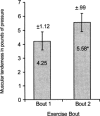Temporal Pattern of the Repeated Bout Effect of Eccentric Exercise on Delayed-Onset Muscle Soreness
- PMID: 12937441
- PMCID: PMC164305
Temporal Pattern of the Repeated Bout Effect of Eccentric Exercise on Delayed-Onset Muscle Soreness
Abstract
OBJECTIVE: To determine the temporal pattern of the repeated bout effect of eccentric exercise on perceived pain and muscular tenderness associated with delayed-onset muscle soreness (DOMS). DESIGN AND SETTING: Subjects completed 2 identical eccentric exercise bouts separated by 6, 7, 8, or 9 weeks. The experiment was conducted in a biokinetics research laboratory. SUBJECTS: Sixteen male and 15 female untrained subjects (age = 24.59 +/- 4.42 years, height = 171.71 +/- 7.81 cm, weight = 73.00 +/- 11.20 kg). MEASUREMENTS: Two physiologic characteristics of DOMS were measured immediately before and 0, 24, 48, and 72 hours after each eccentric exercise bout. Perceived pain was measured using a visual analog scale (VAS), and muscular tenderness was measured using a punctate tenderness gauge (PTG). RESULTS: Two 4 x 2 x 5 (group x bout x time) analyses of variance with repeated measures on the bout and time factors were performed on the VAS and PTG data. Significant (P <.05) main effects were found for group, bout, and time for the VAS and the PTG data. No significant interactions were detected. Post hoc analysis revealed significantly less perceived pain for the 9-week group than the 8-week group. The 7-week group had significantly less and the 8-week group had significantly more muscular tenderness than any other group. Perceived pain and muscular tenderness were significantly less after exercise bout 2 than after exercise bout 1. All subjects had significantly less perceived pain and muscular tenderness pre-exercise than 0 and 24 hours after the eccentric exercise bouts. CONCLUSIONS: An effective prophylaxis for perceived pain and muscular tenderness associated with DOMS is the performance of an eccentric exercise bout 6 to 9 weeks before a similar exercise bout.
Figures






Similar articles
-
Delayed onset muscle soreness : treatment strategies and performance factors.Sports Med. 2003;33(2):145-64. doi: 10.2165/00007256-200333020-00005. Sports Med. 2003. PMID: 12617692 Review.
-
Muscle tenderness and peak torque changes after downhill running following a prior bout of isokinetic eccentric exercise.J Sports Sci. 1996 Aug;14(4):291-9. doi: 10.1080/02640419608727714. J Sports Sci. 1996. PMID: 8887208 Clinical Trial.
-
Effects of massage on delayed-onset muscle soreness, swelling, and recovery of muscle function.J Athl Train. 2005 Jul-Sep;40(3):174-80. J Athl Train. 2005. PMID: 16284637 Free PMC article.
-
Electromyographic analysis of repeated bouts of eccentric exercise.J Sports Sci. 2001 Mar;19(3):163-70. doi: 10.1080/026404101750095295. J Sports Sci. 2001. PMID: 11256821
-
The effect of physical exercise on anticancer immunity.Nat Rev Immunol. 2024 Apr;24(4):282-293. doi: 10.1038/s41577-023-00943-0. Epub 2023 Oct 4. Nat Rev Immunol. 2024. PMID: 37794239 Review.
Cited by
-
Dehydration and symptoms of delayed-onset muscle soreness in normothermic men.J Athl Train. 2006 Jan-Mar;41(1):36-45. J Athl Train. 2006. PMID: 16619093 Free PMC article.
-
Reduction of delayed onset muscle soreness by a novel curcumin delivery system (Meriva®): a randomised, placebo-controlled trial.J Int Soc Sports Nutr. 2014 Jun 18;11:31. doi: 10.1186/1550-2783-11-31. eCollection 2014. J Int Soc Sports Nutr. 2014. PMID: 24982601 Free PMC article.
-
Assessment of the quadriceps femoris muscle in women after injury induced by maximal eccentric isokinetic exercise with low angular speed.J Sports Sci Med. 2007 Mar 1;6(1):106-16. eCollection 2007. J Sports Sci Med. 2007. PMID: 24149232 Free PMC article.
-
Metabolic implications of resistive force selection for oxidative stress and markers of muscle damage during 30 s of high-intensity exercise.Eur J Appl Physiol. 2004 Jul;92(3):321-7. doi: 10.1007/s00421-004-1090-9. Epub 2004 Apr 20. Eur J Appl Physiol. 2004. PMID: 15098126 Clinical Trial.
-
Delayed onset muscle soreness : treatment strategies and performance factors.Sports Med. 2003;33(2):145-64. doi: 10.2165/00007256-200333020-00005. Sports Med. 2003. PMID: 12617692 Review.
References
-
- Segan D J, Sladek E C, Gomez J, McCoy H J, Cairns D A. Weight lifting as a cause of bilateral upper extremity compartment syndrome. Physician Sportsmed. 1988;16(10):73–76. - PubMed
-
- Stauber W T. Delayed onset muscle soreness and pain. In: Zachazewski J E, Magee D J, Quillen W S, editors. Athletic Injuries and Rehabilitation. WB Saunders Co; Philadelphia, PA: 1996. pp. 92–97.
-
- Faulkner J A, Brooks S V, Opiteck J A. Injury to skeletal muscle fibers during contractions: conditions of occurrence and prevention. Phys Ther. 1993;73:911–921. - PubMed
-
- Francis K T. Delayed muscle soreness: a review. J Orthop Sports Phys Ther. 1983;5:10–13. - PubMed
-
- Gulick D T, Kimura I F. Delayed onset muscle soreness: what is it and how do we treat it? Res Rev. 1996;5(3):234–43.
LinkOut - more resources
Full Text Sources
